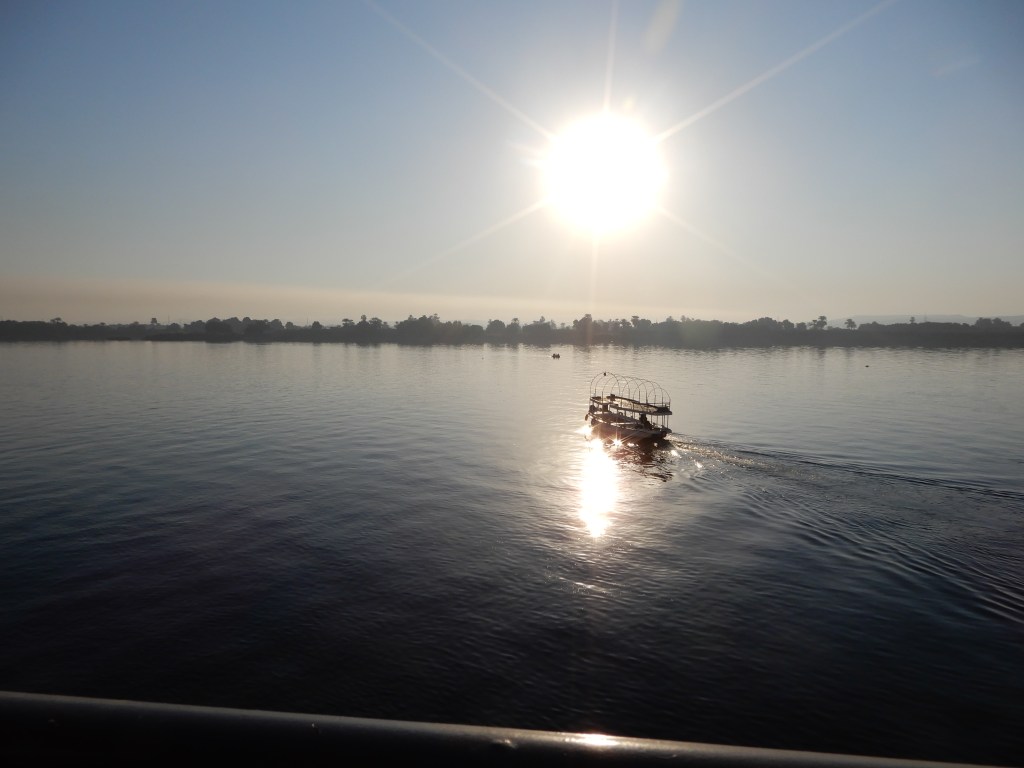
We awoke to a glorious day.The Nile shimmered under the rising sun. We had left Luxor and travelled by night to the town of Efu located on the West Bank of the Nile. Here we were going to visit the Temple of Horus. Our guide had warned us that our mode of transport may upset us but that the temple was a must to see. He wasn’t wrong.
We departed this view on one side of us, walked through the five boats that were moored closer to the wharf than we were and arrived in a hot, dusty town where the shrill noise of men shouting and horse and carriage rattling on the pavements was deafening. Each person was given a spot in a carriage with one or two other people. Strict instructions were given that we had to take the number of the carriage because that would be the carriage that returned us to the dock.

Roger and I clambered into our carriage and off we took at a gallop, the horse being whipped to speed. I was scared stiff and clung on, unable to take any photos of the town that would have looked quite interesting at a slower rate. Where the road would take two carriages I felt as though I was back in Queen Boedica times as the chariots went full pelt trying to overtake. On the other side of the road empty carriages returned. The race to pick up the tourists was on.


On our arrival we disembarked at a rudimentary shelter thankful to have arrived alive and dreading the trip back. We then had to negotiate what had become known after the Valley of the Kings as the Valley of the Vultures whilst the ever present watchful eye scanned us for any hint of terrorism. The only act any of us felt like performing was on those horse handlers.

The Temple of Horus is the best preserved temple in Egypt being situated high enough above the Nile to be safe from flooding.


This temple was built 237 BC and is important because its intactness allows the reading of the heiroglyphs to tell full stories. It also tells details of its construction and the drama between Seth and Horus. It was completed by 57 BC. In 391 whilst under Roman rule pagans were persecuted and non Christian carvings were damaged as they removed faces and other bits and pieces of the reliefs.
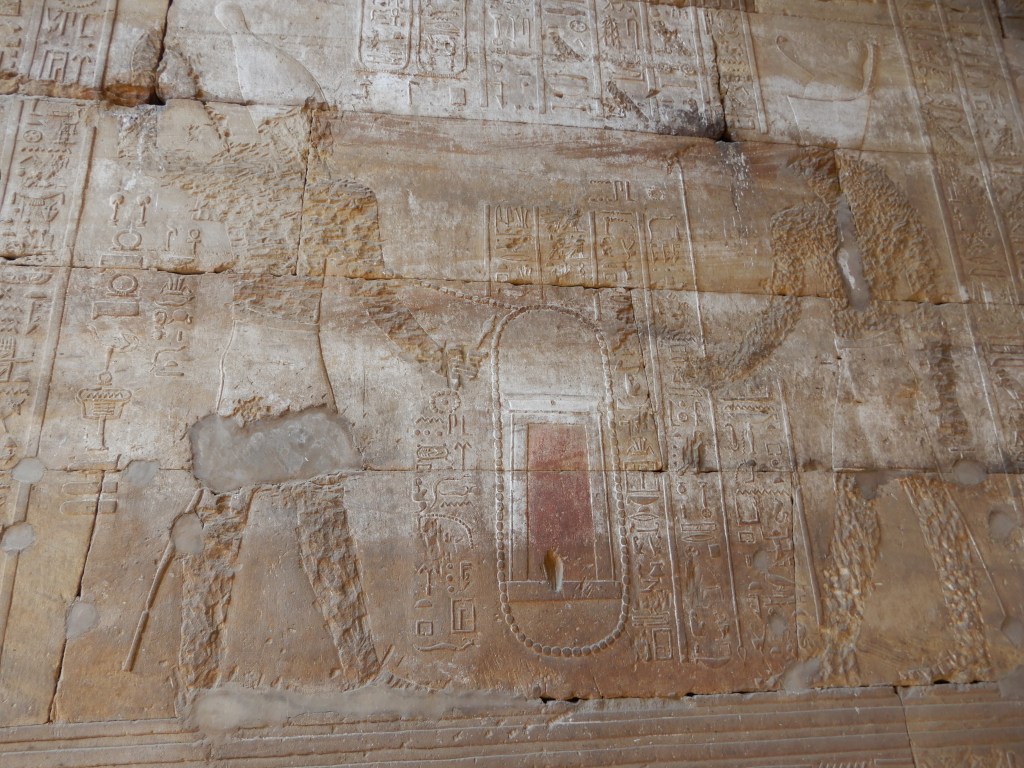
The blackened ceiling in the hypostyle hall is thought to have been the result of arson intended to destroy the non christian imagery.


Everywhere in the temple are doves (perhaps pigeons) roosting. I like to think of them as doves as they represent the divine, showing the hand and presence of God – an apt symbol to be in a temple I thought. Our guide however, saw them as bit shitters whose excrement was damaging the structure and the process of cleaning it off damaging it some more.
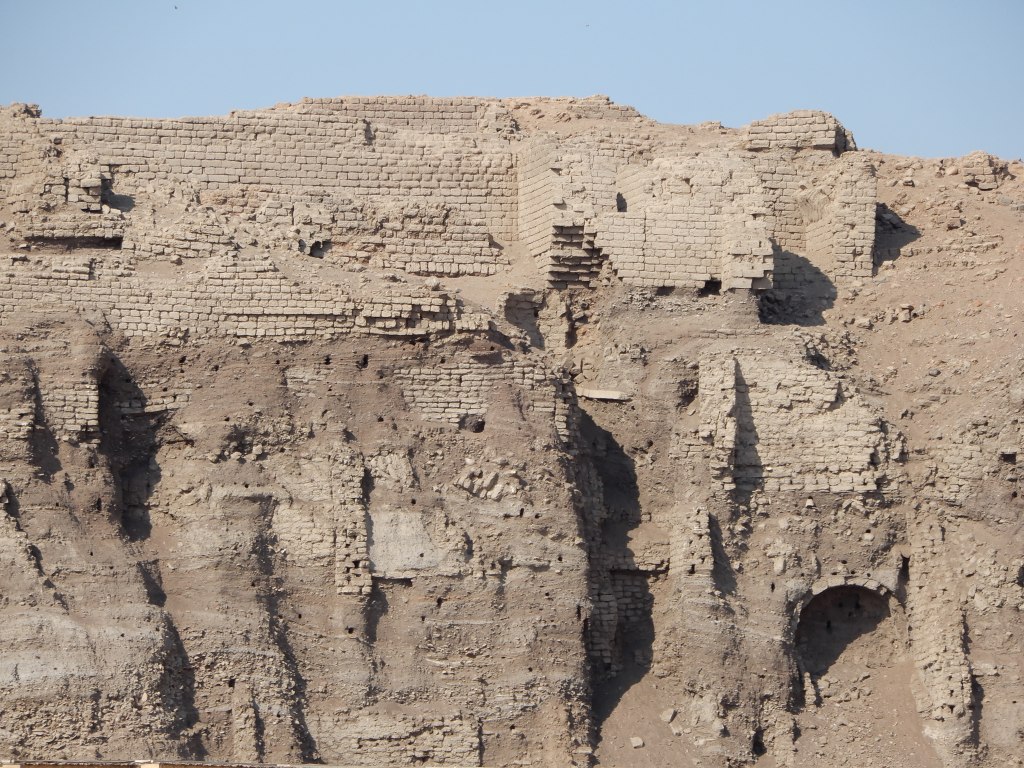
Over time the temple became buried beneath 12 metres of sand. Locals built houses on top of the temple. By 1798 the only thing visible of the temple was the upper portion of the entry pylon seen by a French expedition. In 1860 excavation of the temple began and continures today.

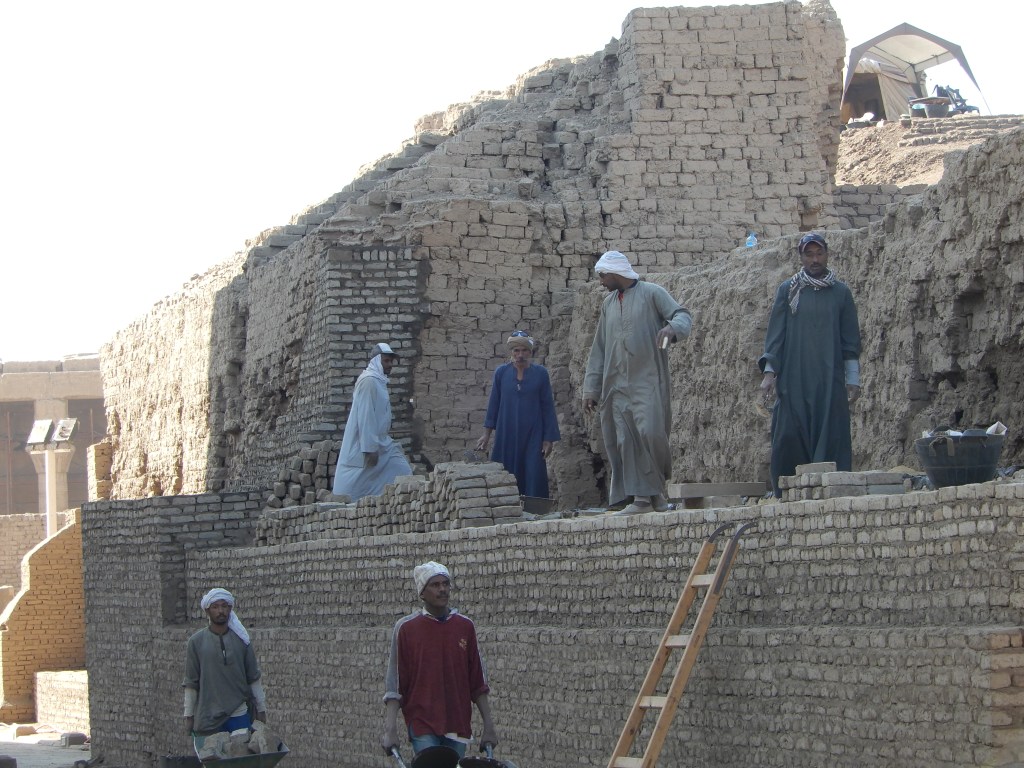


We left the temple of Horus, back out through the Valley of the Vultures to await our carriage. Whilst waiting we saw one coming in quickly and overturning throwing the tourist out. None of us wanted to return by this form of transport and we begged our guide to get us a taxi. Not possible he told us. The carriage trips are these men’s only form of income and without it they wouldn’t survive the depth of poverty that they would have to endure. To prevent this the town’s council had forbade taxis and toktoks were not permitted in the vicinity.
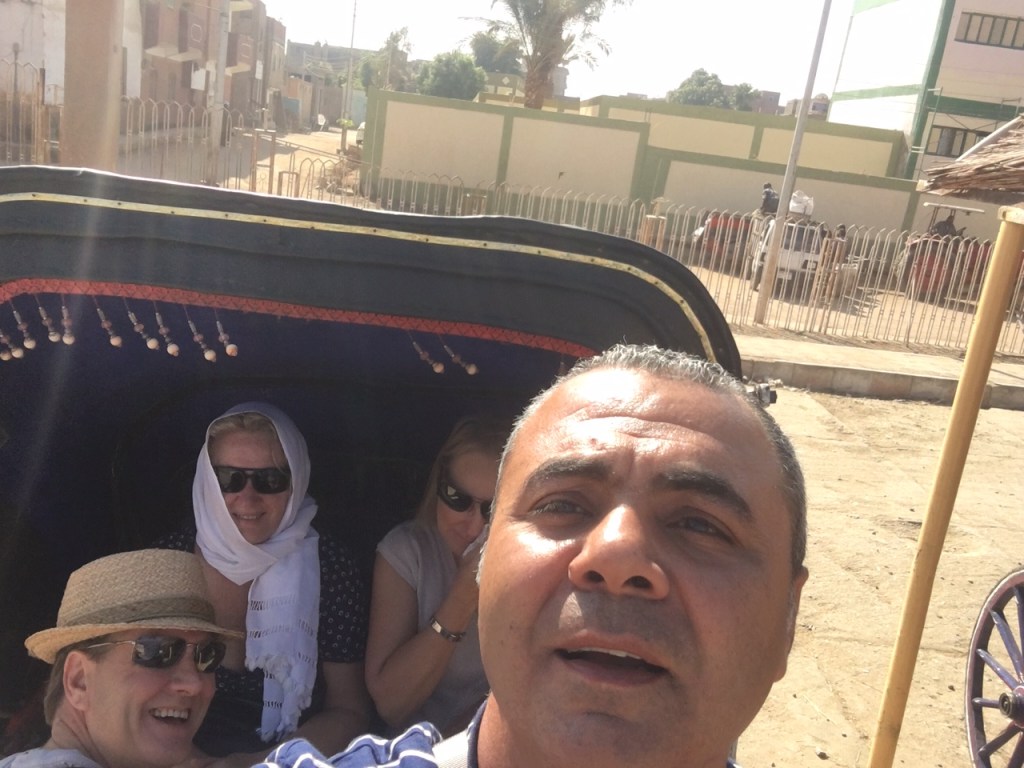
For one of our group this was too much and we decided that we would write and tell the tour company that although the Temple of Horus was well worth a visit we would prefer to forgo that rather than travel with men who sped and didn’t take good care of their horses. I don’t know how many of us did end up writing. I admit by the time I arrived home I had so many other things I was thinking of I didn’t but on writing this now I wonder what is the right thing to do. Perhaps the tourist company should say that it will only send their clients with horses that are not whipped and are fed well.
Back on the boat we prepared for another night on the Nile.






That bothers me about the horses, but tourism is also part of the problem, so I’m not sure what the right course of action is. But I love seeing through your eyes. What incredible structures.
LikeLiked by 2 people
I agree Charli. It is such a difficult thing. People live in such poverty is it right to take away their ability to earn and I learnt in Vanuatu that values change when poverty is involved. Without vets to spay dogs the packs were large and savage and malnourished therefore hungry. Not pleasant to come upon. Then you saw the protein deficient kids and suddenly you condoned the eating of dogs. Not something as a dog lover I’d contemplate doing here but I have the luxury that they don’t have.
LikeLiked by 1 person
Pingback: Sounds of Egypt: Travel Thoughts 12 | Reflections and Nightmares- Irene A Waters (writer and memoirist)
We did not see Edfu and never took a carriage trip when we were on our tour. Thanks for adding to my memories!
LikeLiked by 2 people
You’re welcome. We took another carriage trip in Luxor but the animals were rescues, well fed, not whipped or mal treated and the tourist dollar went to animal rescue and feed as well as providing local employment. A win win situation that if eEdfu adopted would see them with happier tourists
LikeLiked by 1 person
Pingback: Two and three wheels in China: Bikes, motorbikes and trikes: Cee’s fun Fotos | Reflections and Nightmares- Irene A Waters (writer and memoirist)
Very sad. I was at Edfu in 2009, and I was struck by how the horses were very well cared for, and I never saw any buggie going any faster than a gentle trot. I’m a long-time horse owner, and so well able to tell when horses are well cared for, and I only saw one horse that was moving lame and looked poorly cared for. Our guide told us it hadn’t always been that way, but that tourists complaints in earlier years had caused a humane society to be set up to regulate care for the Edfu buggy horses. That’s when the shelter was built (that shelter is more than most horses in America have to protect them from sun) was built, as well as water troughs provided for the horses, as they stood at the temple. It sadly seems that something has changed, and some of the regulation of the horse cabs at Edfu has been removed. Because it was tourist complaints that were effective earlier in gaining more humane conditions for the Edfu horses, I’d say tourists writing now about the upset and fear, and that makes them advise others to avoid Edfu, WOULD result change. My buggy ride thru Edfu was one of the most enjoyable experiences of my 3 weeks in Egypt. The slow and comfortable ride through the town, seeing people going about their lives without the barrier of a dirty bus window, was wonderful. Wish you’d had a similarly lovely experience, rather than fear for your safety and seeing animal abuse. But how exciting that you were able to walk in the area of the ancient city of Edfu being excavated by archeologists! That wasn’t an option when I was there. And FYI, the soot on the temple ceilings isn’t from arson….you can’t burn down a stone building:) It is because after the temples were no longer used for worship, people lived in them, and it is soot from cooking and heating fires occurring over as much as 1000 years. It was both the Coptic Christians and then later the Muslims who defaced the images of the ancient gods.
LikeLike
Thanks Lynne for your wonderful comment. Sorry I am so long in replying. I’m glad that there was a time that the horses were treated better. We had a journey around Luxor in horse and buggy which was like the experience you described and it was wonderful. The sights, sounds and smells took on a different dimension.
Certainly people lived and cooked in the temple and it would have had an effect on the walls. I know my grandmother smoked and her walls and ceilings obviously suffered from the smoke. It is questionable though and many do think that fires were purposefully lit to remove pagan symbols. The following is from a history site. We were told it by our guide who was an Egyptologist.
“The temple was the largest one dedicated to Horus’s cult in all of Egypt and would have hosted many festivals and celebrations held in his honour. Its size gives an idea of the prosperity of the Ptolemaic era, and the richness of its inscriptions has contributed greatly to our knowledge of Egypt as a Hellenistic state. The temple continued as an important place of worship until 391 AD when Roman emperor Theodosius I issued an edict banning paganism throughout the Roman Empire. Christian converts attempted to destroy many of the temple’s reliefs while black scorch marks on the ceiling of the hypostyle hall suggest that they tried to burn it to the ground.”
I agree with you – being stone it would have been a big ask.
Aren’t we lucky we that we got to see the ancient world first hand. I don’t know when we will be able to travel like that again in the changed world circumstances.
Cheers Irene
LikeLike
A diificult problem as far as the horse welfare is concerned as I understand from the boat companies that the carriage drivers will not allow tourists to use other forms of transport …ie tuk tuk and will use any means possible ( some violent) to intimidate the tourists and companies. Not a very nice environment to go as a tourist where you are made to watch that level of abuse, outright cruelty, and neglect to those poor poor horses. It was far worse that I could imagine and couldn’t go .
LikeLike
Yes I had no idea prior to going and have to say the only way it is likely to stop would be if tourist companies just refused to visit. That would soon change the authorities view if the tourists stopped coming.
LikeLike